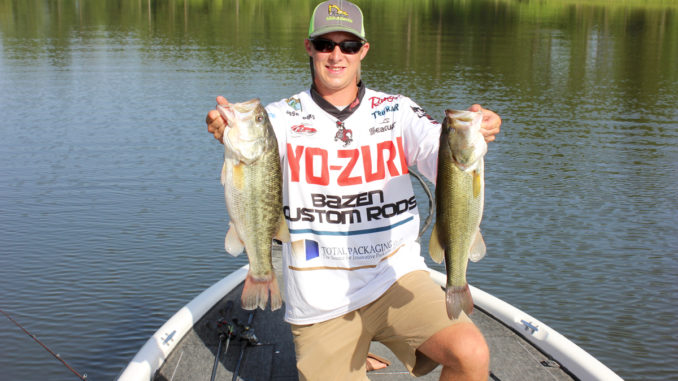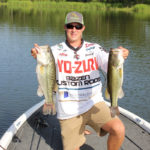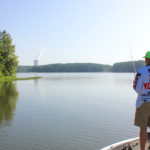
Don’t worry about targeting spawners; you can have great days in April catching Shearon Harris Lake’s bass coming and going from bedding areas.
As April arrives at Shearon Harris Lake, one thing is for certain: the spawn is irrefutable. Waves of buck bass and fat females will be hitting the banks and preparing beds, eager to deposit the eggs they’ve carried through the winter before retreating to make room for another group. Although it’s a staple of many fisherman to sight-cast to shallow, bedding bass, two top-notch anglers often catch their biggest fish of the year by targeting bass that most boats are sitting on top of.
“I’m not a bed fisherman,” said Josh Hooks of New Hill. “The main reason I don’t is because the beds at Harris are super obvious; they’re glow-in-the-dark orange, and they get a lot of pressure. I’d rather catch numbers of fish than try to hand-pick five off the beds. Besides, you don’t see the 7- or 8-pounders out there in the obvious places. They all bed in deeper water, 6 feet or more. Those fish get that big for a reason; they know how to survive.”
To catch better numbers of fish, Hooks opts to back off the bedding areas near the backs of creeks and pockets and concentrate on nearby secondary points. About a cast-and-a-half from the bank, he’s in range of larger, unseen spawners, and he doubles his chances by targeting fish staging near the bedding areas and those leaving after they’ve finished their business.
“I go the prespawn or postspawn route,” he said. “When you fish those inner thirds of the creeks or guts of the pockets, you’re going to get both fish; it’s not like you’re targeting just one. You can go out there one day, and the fish will be prespawn, and the next day, there will be a wave that’s leaving the beds. A lot of people think that during the spring, all the fish are nose on the bank, but they’re underneath them half the time.”
Hooks favors secondary points with a pea gravel or clay bottoms, noting that submerged brush and stumps are also a plus, though relatively scarce.
“In reality, the better fish are going to come from areas with more cover, and the dominant cover at Harris is the grass,” he said.
Although the hydrilla that fills many of the creeks will not kick into high gear until the warmer months, the native primrose will begin to emerge in April, and finding it will put anglers in the fast lane.
Another angler who snubs the beds and pays attention to the growth of primrose on secondary points is Jaime Fajardo of Raleigh, who partners with Hooks in team tournaments around the area.
“When the water gets around 60 to 65 degrees, the buds on the primrose will start to turn green, and it’ll start getting green leaves,” he said. “Before the grass mats out later on in the summer, it starts with isolated patches of grass, which are great targets for fish.
“The grass has oxygen, and it’s holding heat,” Fajardo said. “The primrose grows in shallow water, so you’re going to have fish pulling up to stage on it, sunning themselves and using it for protection. Some fish will be bedding in and around it. Even if it’s only one strand of primrose with a few leaves on it, they’ll be a fish on almost every one of them in the back of the pockets and back of the creeks. It doesn’t matter if you’re on the south, middle or upper end of the lake.”
Rather than blind-cast soft plastics, Fajardo takes advantage of the defensive nature of bass during the spawning stages and utilizes an often overlooked approach.
“I use a LIVETARGET topwater frog as a search bait,” he said. “I start throwing it at 52 to 53 degrees; 60 degrees is prime time.But you’re not always going to catch fish on it. You’ll have them roll on it and slap it with their tail; they might just be defending the bed area. It makes them show themselves so I can follow up with a Senko or trick worm.”
“Low light doesn’t matter for topwater this time of year,” said Fajardo, who throws his frog on 50-pound braid. “You can catch them on top in the middle of the day. You have to think, when those fish are in 1 to 4 feet of water and you throw something over their head, they’re not going to do anything but react to it or try to eat it.”
Hooks has a special affinity for Senkos.
“If I have four rods on deck, I’d probably have a flashy jerkbait, a jig, a shaky head and a Senko.” he said. “If you can get a day without a lot of wind, you can damage them pretty bad with a wacky rigged Senko on those secondaries. In April at Harris, the motto is throw the wack or get beat by it.”
However, a Senko is a bait best reserved for isolated targets, so Hooks relies on his other favorites to keep the ball rolling.
“You’ve got to cover water,” he said. “You’re not going to catch 25 on one point; but you might catch a couple on each one. I grew up a wormer, so for me, I feel like I can go out there and throw a shaky head or a jig and be successful.”
When he fishes a shaky head worm, Hooks prefers to use the lightest size possible for shallow water and to avoid hang-ups, usually a ⅜-ounce.
“This time of year, I like natural colors: watermelon and green pumpkin,” he said. “I like a heavier jig, though, at least a ½- to a ¾-ounce on the deeper points. I feel like they’re going to eat a T-bone instead of a pork chop. With a jig, I’m usually throwing a peanut butter-and-jelly color or black and blue with a soft-plastic trailer.”
The strategy for jig and shaky head fishing is largely the same.
“I just drag it along the bottom, shake it in place, let it sit, and drag it again,” Hooks said. “During the spawn, the fish aren’t so bait-oriented. I feel like if you can drag it by one, he’s going to react and pounce on it.
“On those points, you can’t ever rule out a jerkbait. A jerkbait is famous at Harris for catching real good fish. It can be great at first light, but then it dies. I’ll switch to the slower-moving baits and pick it up again around 12 or 1 when the water temperature is two to three degrees warmer. I usually throw a clown or bone color on 15-pound fluorocarbon line.”
Covering only 4,100 surface acres, Harris is on the small side for a trophy bass fishery, but it has no shortage of considerable specimens.
“Anytime you go to Harris, especially in the spring, you have a legitimate chance at catching an 8-pounder or a 30-pound bag,” Hooks said. “You can catch fish in every creek in the whole lake. They’re all good. The back of Cary Branch and Little White Oak Creek are awesome, and you can catch fish in Tom Jack Creek every time you go in there. You can either stay with the crowd or do what I do and get away from them.
“When you can find 60-degree water, the bite will usually be good. The back of the creeks will warm up quicker, so I start there and work my way out. When I go 100 to 200 yards without catching a fish, that’s when I know I’ve gone too far. I’ll turn around and go down the bank on the other side.”
DESTINATION INFORMATION
HOW TO GET THERE — Shearon Harris Lake is a short drive southwest of Raleigh down US 1. Two public boat ramps service the lake: Cross Point Landing on Crosspoint Road on the southern end, accessed from NC 42 via Christian Chapel Road; and Holleman’s Crossing ramp at mid-lake just off US 1 via New Hill-Holleman Road and Bartley-Holleman Road.
WHEN TO GO — Bass fishing often starts to ramp up from around the end of February or early March when water temperatures first break into the 50s. The first wave of spawners is likely t omove around the first of April, and subsequent waves will enter and exit until May, with most fish moving offshore in June.
BEST TECHNIQUES — Bass can be targeted in April with a variety of baits, including black/blue and PB&J jigs, watermelon or green-pumpkin shaky head worms and Senkos, the latter fished wacky style. Jerkbaits in bone and clown colors are good on slightly deeper points early in the morning and after the water warms at mid-day, and topwater frogs and buzzbaits fished on 50-pound braid should be at ready when the first topwater bite fires off. Go with medium-heavy baitcasting gear except when fishing smaller plastics. Good spots include newly emerging primrose on secondary points and in pockets and guts.
FISHING INFO/GUIDES — Greg Griffin, Greggofish Guide Service, 919-434-4183, www.greggofish.com; Joel Richardson, 336-643-7214, www.joelgrichardson.com; Jeffrey Thomas, Carolina Outdoors, 919-770-4654 www.carolinaoutdoors.net. See also Guides and Charters in Classifieds.
ACCOMMODATIONS — Hampton Inn and Suites, Holly Springs, 800-230-4134; Comfort Inn, Apex, 800-997-5148; Holiday Inn Express, Apex, 800-997-5149.
MAPS — Fishing Hot Spots, 800-ALL-MAPS, www.fishinghotspots.com; Delorme’s North Carolina Atlas and Gazetteer, 207-846-7000, www.delorme.com.info.





